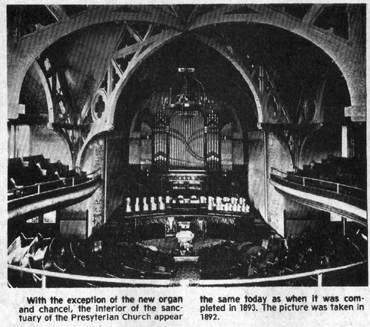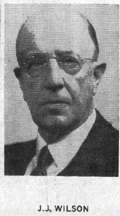February 26, 1981


Picture #1 – With the exception of the new organ and chancel, the interior of the sanctuary of the Presbyterian Church appear the same today as when it was completed in 1893. The picture was taken in 1892.
Columnist’s Note: Because of the length of last week’s article about the Presbyterian Church, there was not sufficient space to include my apology for writing about the Presbyterian Church, the third oldest in Fostoria, ahead of St. Wendelin which is second oldest. Since the Presbyterians are celebrating their 125th Anniversary, I felt it was appropriate to make the switch. The St. Wendelin story will appear soon.
Lack of space last week resulted in omitting a few paragraphs which were important, especially for the newer generation of Presbyterians, consequently they are the leadoff today.
When the Presbyterians first church, 340 W. Fremont St. was completed, nine new members were welcomed into the church. They were: Mary and Flossie Dana, Mrs. Sarah Schuyler, Mr. and Mrs. George Geer, Mr. and Mrs. Thomas D. Stewart, F.R. Stewart and A.D. Stewart.
Mary and Flossie Dana were part of Dr. Dana’s family, one of the early doctors who served the village of Risdon, and lived in the oldest house in Fostoria, at Countyline and Summit, now owned by Mr. and Mrs. Elwood Kimes.
F.R. Stewart’s home still stands on E. Crocker St. It is the large house painted green, on the north side, next to Kinn’s garage.
PROMINENT CITIZENS
When the Presbyterians dedicated their first church and the organ, there were many fine musicians among members to participate, including Mrs. Mamie Leonard Allen, and Mrs. Jessie Foster Myers. Mrs. Allen, wife of E.W., local banker, continued to serve the Presbyterians in their first church and then in the later one as organist and choir director. Jessie Foster Myers was the daughter of Honorable Charles Foster, Governor of Ohio and later Secretary of the U.S. Treasury.
Another item of interest, especially to Presbyterians, is the historical note that Rev. Turner, the church’s first pastor, did not return to Fostoria after the Civil War, but accepted a call to be pastor at Newburg, Cuyahoga County, Ohio.
Adding to last week’s mention of Dr. C. D. Martin’s pastorate, it should be mentioned that during his 10 years, one of the important achievements was the organization of the We Boys (Men’s Bible Class). It was an important activity for men in the church, drawing 100 or more men every Sunday morning, with E. W. Allen as teacher.
MANSE COST $7,000
It was during Martin’s pastorate that the manse was built beside the church, at a cost of $7,000. Martin was the first to occupy it. Previously a manse was located at 314 N. Union St., where the Marvin D. Rupp family now live.
Those following Martin, for the next 24 years were, in order: Rev. E. C. Pires, Rev. Francis Wilbur, Rev. T. H. McDowell, Rev. James G. Waits, Rev. J. J. Wilson, Rev. G. O. Brown.
The historical records describe Pires very briefly: “he was a large man, with a commanding personality and with unusual oratorical ability.” I started going to the Presbyterian Church in 1914, during Pires pastorate, and continued for forty years. My first Sunday School teachers were: Mrs. Leonard, wife of the doctor, Anna Gilbert and Gertrude King.
Rev. Wilbur, who followed Pires, was an elderly man when he became pastor. Both he and his wife contributed to the church. He was scholarly looking, with white hair, and wore wing-type collars. He was highly intelligent and knew the Bible well. The only thing that detracted from his masterful sermons was occasional stuttering. When I was sick with scarlet fever and our house was quarantined, he called and talked to me through the window and said a prayer.
Rev. McDowell followed Rev. Wilbur, and was the pastor during my high school years. He was active in the church’s youth work, and Christian Endeavor, and interdenominational organization in most Protestant churches, with meetings on Sunday evenings.
Rev. James Waits, following McDowell, is credited with fostering the remodeling the Sabbath school room and adding the Parish Room on the second floor.
LONGEST PASTORATE
Rev. J.J. Wilson was the next pastor, and remained for 17 years…longer than any other up to the present. During his time the membership grew to 500. He retired in 1947. However, he was still around to participate when the church observed its 100th Anniversary in 1956. More about Wilson in a separate story.
Rev. G. O. Brown followed Wilson. He was a good mixer, organizer and a fine preacher. He was active in promoting scouting in the church and community. Membership during his pastorate reached 670, and it was during his term that the 100th Anniversary was observed, and the new organ and chancel were in- stalled.
Brown never referred to a manuscript or note when preaching. He never preached more than 30 minutes, sometimes less…believing a good, brief sermon was more effective.
Our son Nathan, and also Richard Dalton, both received their God and Country Award in scouting in the church during Brown’s pastorate.
DECISION TIME
In the late 1950’s, the church as faced with a decision…should they remodel and update the building that was erected in 1893, or look for a new site and rebuild. They made the decision to remodel, and to remove the manse from the site, and use that area for an addition.
The decision resulted in preservation of the beautiful, original sanctuary, but with addition of the new organ and chancel. Many other parts of the original church were altered and updated.
Gladys Andes Harrison’s generous donation in her will assisted in the building of a completely new educational wing, which has been in use for several years. In addition to being a valuable asset to the church’s activities, it is also used by the Head Start program, and some weekday activities of St. Wendelin.
During this period, the church has been served by/Rev. Glenn Ogden, Rev. Richard Sinclair, Rev. Charles Rominger, Rev. Eric Erickson, and presently Rev. Robert E. Reed. Each of those pastors has contributed to the church’s welfare and the physical building program in various ways.
It is appropriate to say that the local Presbyterian church is well prepared to serve its congregation and community at this point in its history.
The accompanying list of pastors of the Fostoria Presbyterian church will pro- vide all the names and years of service, and be a valuable reference for the many who will preserve these articles.
DR. WILSON’S PASTORATE UNIFIED CHURCH CONGREGATION
Picture #1 (missing) – T.H. McDowell
Picture #2 (missing) – G. Ousley Brown
Picture #3 (missing) – Glenn Ogden
Picture #4 – J.J. Wilson
PRESBYTERIAN PASTORS
Rev. Wm. C. Turner 1857-1861
Rev. S.C. Curtis (Stated Supply) 1861-1864
Rev. E.J. Alden (Stated Supply) 1866-1869
Rev. Wm. MacLarn (Stated Supply) 1870-1871
Rev. J. Emery Fisher (Stated Supply) 1872-1873
Rev. David Van Dyke (Stated Supply) 1873-1877
Rev. Joseph Hughes (Stated Supply) 1877-1880
Rev. William Foulkes (Stated Supply) 1881-1888
Rev. Henry Gardner 1889-1891
Rev. R. H. Coulter (Stated Supply) 1892-1893
Rev. Francis A. Wilbur, D.D. 1918-1921
Rev. Howard McDowell 1921-1926
Rev. James A.G. Waits 1926-1929
Rev. John J. Wilson, D.D. 1930-1947
Rev. G. Ousley Brown 1947-1956
Rev. Glenn Ogden 1957-1963
Rev. R.S. Sinclair 1964-1969
Rev. Charles Rominger 1970-1972
Rev. Eric L. Erickson 1973-1978
Rev. Robert E. Reed 1979–
(Note: Stated Supply indicates temporary).
On this 125th Anniversary of the local Presbyterian Church, special tribute should be paid to Dr. J.J. Wilson, its pastor from 1930-1947. He served longer than any other pastor in the church’s history.
He came to Fostoria from Oshkosh, Wisconsin at a time when the church needed a pastor to unify and build the congregation.
Many fine things could be said about Dr. Wilson. In my canvass of older members, the unanimous opinion has been that he was a fine pastor…which is one of the prime requisites for dealing with a congregation…concern for and readiness to minister to people.
He was always kind, compassionate, tactful and ready to minister.
As a member of that church for 40 years, his greatest benefit to me was his administering of Holy Communion…a service I always looked forward to. His remarks on those occasions were not long, but his brevity and choice selection of words never failed to remind me of how Christ suffered for our sins, to provide salvation and life everlasting. Tears came easily with his sincerity and tenderness.
PEACE PRAYER CHOSEN
In going through historical data, I came across a newspaper clipping about Dr. Wilson which few many remember, and others possibly never knew. It was printed in the Daily Review, dated Aug. 24, 1945.
“Dr. John J. Wilson, pastor of the First Presbyterian Church, Fostoria, Ohio, has been honored by having his prayer for peace selected to be incorporated in a volume of prayers suitable for inscriptions on monuments memorializing the nation’s dead of World War II.
“C. P. Reynolds, of Toledo, Ohio, president of Monument Builders of America, announced today that the Rev. Dr. Wilson’s prayer is one of the most beautiful he has received from ministers all over the country.”
Dr. Wilson’s prayer, is, in part, as follows:
“Almighty God, we hold in memory the life unselfishly given for our security, and thank Thee that Thou dost inspire to acts of courage and bravery. As we honor the heroic life so spent, we pray that we who live may be brave enough and strong enough to be steadfastly against all that makes for strife and war, and firmly for that which makes for the nobility and blessedness of peace and brotherhood.”
Rev. J.J. Wilson is the only one of all who pastored the local church to live in Fostoria after retirement. He died here in 1960, and is buried here, as is his wife.
Both were definitely a part of the community, as well as the church.